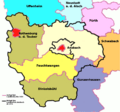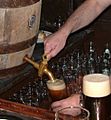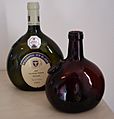Franconia facts for kids
Franconia (in German: Franken) is a special part of Bavaria, a big state in Germany. It's located in the northern part of Bavaria and has its own unique history and culture. Franconia is divided into three smaller areas: Upper Franconia (Oberfranken), Middle Franconia (Mittelfranken), and Lower Franconia (Unterfranken). The largest city in Franconia is Nuremberg.
Other important cities in Franconia include Coburg, Aschaffenburg, Würzburg, Erlangen, Fürth, Bamberg, Bayreuth, Schweinfurt, and Hof.
Contents
Geography and Nature
Franconia is a beautiful region with diverse landscapes. You can find rolling hills, thick forests, and lovely river valleys here.
Rivers and Lakes
Several important rivers flow through Franconia, like the Main, Regnitz, and Altmühl. These rivers have shaped the land and are often used for boating and other fun activities. Franconia also has some nice lakes, such as the Großer Brombachsee, which is a popular spot for swimming and water sports.
Natural Parks and Forests
The region is home to several natural parks, offering great opportunities for hiking and exploring. The Franconian Switzerland (Fränkische Schweiz) is famous for its unique rock formations and caves, making it a favorite for climbers and adventurers. Other important forest areas include the Spessart and the Steigerwald.
History of Franconia
Franconia has a long and interesting history, dating back thousands of years.
Early Times
Long ago, the Celts lived in this area. They built strong fortresses, like the one on the Staffelberg. Later, the Romans also had a presence here, building camps and roads, such as the Biriciana camp near Weißenburg. After the Romans, Germanic tribes settled in the region.
Middle Ages
During the Middle Ages, Franconia became an important duchy within the Holy Roman Empire. Many powerful castles and impressive churches were built during this time. Cities like Nuremberg and Würzburg grew into major centers of trade and culture. You can still see many medieval buildings today, like the Nuremberg Castle and the Marienberg Fortress in Würzburg.
Modern Era
Franconia experienced many changes over the centuries, including wars and political shifts. In the early 1800s, most of Franconia became part of the Kingdom of Bavaria. Despite this, the region has kept its unique Franconian identity and traditions.
Culture and Traditions
Franconia is known for its rich culture, friendly people, and delicious food and drinks.
Food and Drink
Franconian cuisine is hearty and tasty. Famous dishes include Schäuferla (roasted pork shoulder) and the small, flavorful Nuremberger Bratwürste. Franconia is also well-known for its beer, especially its unique Rauchbier (smoked beer), and its wine, which is often sold in special flat bottles called Bocksbeutels. Fried Carp is another popular dish, especially in the colder months.
Festivals and Events
Throughout the year, Franconia hosts many traditional festivals. These often include folk music, dancing, and local food. Christmas markets in cities like Nuremberg are also very famous and attract visitors from all over the world.
Famous Places and Attractions
Franconia offers many exciting places to visit.
Nuremberg
Nuremberg is the largest city and a historical gem. Its impressive castle, medieval old town, and famous Christmas market make it a top destination. The city also has many museums where you can learn about its past.
Würzburg
Würzburg is known for its beautiful Würzburg Residence, a UNESCO World Heritage site, and the Marienberg Fortress overlooking the city. It's also a major center for Franconian wine.
Bamberg
Bamberg is another UNESCO World Heritage city, famous for its unique Old Town Hall built in the middle of a river, and its many breweries.
Rothenburg ob der Tauber
Rothenburg ob der Tauber is a perfectly preserved medieval town, often called the "Jewel of the Middle Ages." Its charming streets, old walls, and towers make it feel like stepping back in time.
Images for kids
-
Marienberg Fortress in Würzburg
-
The Steinerne Rinne near Rohrbach, Ettenstatt, county of Weißenburg-Gunzenhausen
-
Tower-like rocks of Upper Jurassic-Corallian Limestone in Tüchersfeld, northern Franconian Jura (Franconian Switzerland)
-
The Celts built the mighty fortress of Menosgada on the Staffelberg
-
Part of Wallenstein's camp around Zirndorf and the Alte Veste
-
The Pellerhaus in Nuremberg was one of the most important buildings of the Renaissance period from 1605 until the destruction of its façade in 1945.
-
The administrative reform in Bavaria in the Franconian county of Ansbach
-
Water wheel at the Regnitz
-
Three Nuremberger Bratwürste in a roll (Drei im Weckla)
-
Fried Carp with beer and salad
See also
 In Spanish: Franconia para niños
In Spanish: Franconia para niños





































